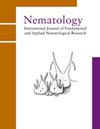Two new species of sedentary nematodes of the genus Meloidodera Chitwood, Hannon & Esser, 1956 (Tylenchida: Heteroderidae) from Mexico
IF 1.2
4区 生物学
Q2 ZOOLOGY
引用次数: 0
Abstract
Two new species of the genus Meloidodera collected in Mexico are described here: M. ferrisi sp. n. parasitising roots of an oak tree in the State of Mexico and M. tecoacensis sp. n. parasitising roots of buffalo bur nightshade in the Tlaxcala State. Meloidodera ferrisi sp. n. is characterised by a spherical female body covered completely by a dark thick cuticular layer, length/width of the female body = 0.8-1.6, stylet = 35-43 μm and second-stage juvenile with average body = 340 μm and average tail length = 35.6 μm. Meloidodera tecoacensis sp. n. is characterised by the female having a spherical body covered with a yellow transparent material, length/width of the female body = 1.1-2.8, stylet = 20-33 μm and second-stage juvenile with average body = 340 μm and average tail length = 29.8 μm. These two species were molecularly characterised using the D2-D3 expansion segments of 28S rRNA, ITS rRNA and COI gene sequences. Phylogenetic analysis revealed that the two new species represent a separate evolutionary lineage within the subfamily Meloidoderinae. An identification key for 12 Meloidodera species is provided.墨西哥扁脊线虫属两新种,Hannon&Esser,1956(扁脊线虫:异脊线虫科)
本文描述了在墨西哥采集的Meloidodera属的两个新种:寄生在墨西哥州橡树根上的M.ferrisi sp.n和寄生在特拉斯卡拉州睡莲根上的M.tecoacensis sp.n。铁球藻(Meloidodera ferrisi sp.n.)的特征在于完全被深色厚角质层覆盖的球形雌性身体、雌性身体的长度/宽度=0.8-1.6,管心针=35-43μm,第二期幼鱼平均体长=340μm,平均尾长=35.6μm。墨西哥瓜的特征是雌性的球形身体覆盖着黄色透明材料,雌性身体的长度/宽度=1.1-2.8,使用28S rRNA、ITS rRNA和COI基因序列的D2-D3扩增片段对这两个物种进行了分子表征。系统发育分析表明,这两个新物种代表了蜜瓜亚科中一个独立的进化谱系。提供了12个甜瓜属物种的鉴定密钥。
本文章由计算机程序翻译,如有差异,请以英文原文为准。
求助全文
约1分钟内获得全文
求助全文
来源期刊

Nematology
生物-动物学
CiteScore
2.60
自引率
33.30%
发文量
67
审稿时长
3 months
期刊介绍:
Nematology is an international journal for the publication of all aspects of nematological research (with the exception of vertebrate parasitology), from molecular biology to field studies. Papers on nematode parasites of arthropods, and on soil free-living nematodes, and on interactions of these and other organisms, are particularly welcome. Research on fresh water and marine nematodes is also considered when the observations are of more general interest.
Nematology publishes full research papers, short communications, Forum articles (which permit an author to express a view on current or fundamental subjects), perspectives on nematology, and reviews of books and other media.
 求助内容:
求助内容: 应助结果提醒方式:
应助结果提醒方式:


